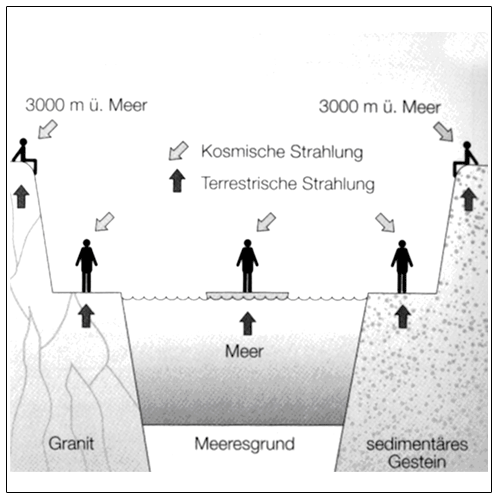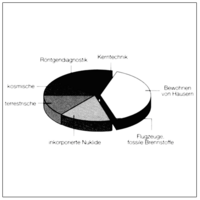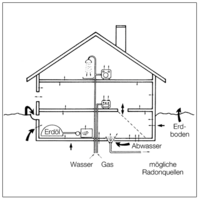Natural radioactivity and radon
The natural radiation sources

The building biology discussion in Germany was triggered by an examination by the Federal Ministry of the Interior in the 1970s, for which the examination report was published in 1978. At that time, the natural concentrations of radium, thorium and potassium were measured in houses and in nature. The occasion for the examination ordered by the Federal Ministry of the Interior was the desire to prove that the radiation in the surroundings of nuclear power plants is lower than the radiation that humans have been exposed to for millennia from the cosmos, from the ground and from materials that surround them daily. As expected, the radiation values measured in the vicinity of nuclear power plants were lower.
At this point the note should be allowed that the population has hardly any concerns with regard to the radiation from perfectly operating nuclear power plants, but rather fears the small, medium or large malfunction and its consequences. However, the examination report did have one effect: A number of building materials came under unjustified criticism through no fault of their own.
Our earth’s interior consists of a liquid core, which is surrounded by a 5 to 40 km thick layer of earth crust. The earth's crust from which our building materials are made today contains uranium and thorium as well as a whole range of other chemical substances. These substances are radioactive, which means they can transform into other substances and thereby emit radiation.
Basically today we distinguish between artificial and natural radiation exposure.
Artificial
radiation exposure includes:
The natural radiation exposure
is divided into:
- X-ray diagnostics and nuclear medicine examinations
- Emissions from nuclear power plants of the general variety
- Emissions due to malfunctions
- Radiation exposures through atomic tests.
- Radiation exposure from the outside, the so-called cosmic radiation, in which high energy radiation falls from the universe onto the Earth,
- Terrestrial environmental radiation, which is naturally present due to the natural radionuclides in the ground, in rocks and in the hydrosphere and atmosphere.
- Radiation exposure from the inside, which concerns the intake of radionuclides through food and water into the human body. But radionuclides can also be absorbed by inhaling the air.
In addition to the natural radiation exposure which all living beings on our planet are exposed to, the natural radiation exposure was changed in numerous ways by technological or civilisational interventions by mankind in nature. Changes in natural radiation exposure may include, but are not limited to, an increase in exposure to cosmic rays, e.g. intercontinental flights at an appropriate distance from the Earth, or exposure to radiation through energy production, i.e. the use of energy raw materials such as coal, oil, gas, which are brought to the surface from within the Earth as they are extracted and release naturally occurring radionuclides during combustion.
Another area of radiation exposure is from the use of diverse consumer goods, for instance the use of instruments with lit numbers, ceramic objects, high-pressure mercury lamps, ignition devices for fluorescent tubes, but also through the preservation of fruit and vegetables, which are briefly irradiated.
Another area is the radiation exposure changed by humans due to the use of building materials. Due to their concentration of naturally occurring radionuclides, various building materials can lead to an increase in natural radiation exposure in buildings. These building materials can be present in their original form such as in pumice products, alum shale, whinstone and granite or occur as waste or ancillary products from industry processes such as phosphorite gypsum, red sludge, fly ash and blast furnace slag. The natural building materials mentioned are materials that can be classified as young rocks in terms of the Earth's age. Depositional rocks or sedimentary rocks such as sand are much older and have already given off a significant amount of their radiation (half life times).
All mineral base substances, so also the building materials manufactured from them, contain small quantities of radioactive substances. Natural parts are radium, thorium and potassium isotope. Radioactivity is the decay of atomic nuclei. During this decay new atoms of lesser mass are created while simultaneously emitting radiation. The specific activity of a radioactive substance is the number of decayed atoms of a substance per second and kg. It is known from the listed elements. If the content of a building material in radium, thorium and potassium is measured, its specific activity can be calculated. It is listed in Bq/kg (becquerel per kg).
|
Type of building material |
Average activity concentration in Bq/kg |
||
|---|---|---|---|
|
40 K |
226 Ra |
232 Th |
|
|
Building sand, gravel |
260 |
15 |
15 |
|
Sandstone |
190 |
19 |
19 |
|
Other natural stones |
480 |
26 |
30 |
|
Lime-sandstone, porous concrete |
220 |
19 |
19 |
|
Other artificial stones |
370 |
33 |
30 |
|
Natural gypsum |
70 |
< 19 |
< 19 |
|
Concrete, concrete blocks |
220 |
22 |
26 |
|
Different aggregate materials |
220 |
22 |
15 |
|
Basalt |
1400 |
41 |
52 |
|
Cement |
150 |
52 |
52 |
|
Granite, shale |
1480 |
56 |
81 |
|
Brick, clinker |
630 |
67 |
63 |
|
Pumice |
890 |
81 |
85 |
|
Slag blocks |
330 |
81 |
104 |
|
Chemical gypsum (phosphorite) |
70 |
520 |
< 19 |
|
Lithoid tuff (Italy) |
1480 |
130 |
130 |
|
Blast furnace slag |
520 |
120 |
130 |
|
Fly ash |
700 |
210 |
130 |
|
Red mud brick |
330 |
280 |
230 |
|
Alum shale concrete (Sweden) |
850 |
1500 |
70 |

This generally accepted formula is insofar correct if it concerns substances that are comparable in gross density. For materials with severely differing gross densities like pumice (0.5) and brick (> 1.0) the actual volume representing the weight is not considered.
During radioactive decay high-energy radiation is emitted. If it hits a body of material, energy is transferred to the body. This energy quantity or also “energy dose” is listed in Gray (Gy. It is weakened when penetrating the material.
The energy transferred per second to a 1 kg body of matter is called “energy dose performance”. The energy dose performance is stated in Gy/s (Gray per second) or as long-time value in Gy/a (Gray per year). If an energy dose hits biological tissue, we talk about “equivalent dose”. The equivalent dose is stated in Sv (Sievert) and means the energy from one Joule that impacts 1 kg tissue (J/kg).
The equivalent dose used to be designated with rem (radiation equivalent man) and was equal to 100 times one Sievert. The equivalent dose performance describes the permanent effect of radioactive radiation on biological tissue.
The respective equivalent doses are a follows, for example:
- X-ray diagnostics approx. 1.5 J/kg
- nuclear medical examinations (mammography) approx. 1.9 J/kg
- the deadly radiation exposure is assumed to be 4 to 5 J/kg.
|
Radiation exposure |
Average effective annual dose of the population in mSv/a |
|||||
|---|---|---|---|---|---|---|
|
Unchanged, natural |
|
|
1,1 |
|||
|
- Cosmic radiation |
0,3 |
|||||
|
- Terrestrial radiation |
0,4 |
|||||
|
- Incorporated substances |
0,4 |
|||||
|
Changed, natural |
|
|
1,3 |
|||
|
- Flying at great heights |
< 0,01 |
|||||
|
- Coal power plants |
< 0,01 |
|||||
|
- Residing in houses |
1,3 |
|||||
|
- External γ-radiation |
0,05 |
|||||
|
- Inhalation of radon |
1,25 |
|||||
|
Artificial |
|
|
1,6 |
|||
|
- Nuclear power systems |
< 0,01 |
|||||
|
- Substances in technology etc. |
< 0,02 |
|||||
|
- Prof. radiation exposure |
< 0,01 |
|||||
|
- Atomic weapons tests |
< 0,01 |
|||||
|
- Spec. incidents |
< 0,02 |
|||||
|
- Medical applications |
1,6 |
|||||
|
- Nuclear medicine |
< 0,02 |
|||||
|
- Radiation therapy |
< 0,02 |
|||||
|
- X-ray diagnostics |
1,5 |
|||||
|
Total |
|
|
4,0 |
|||
The following equivalent dose performances are meant to clarify which radiation we are currently exposed to:
- natural radioactivity of the ground approx. 1 mSv/a (milli-Sievert per year)
- in the Black Forest to approx. 20 mSv/a
- in solid houses approx. 0.5 mSv/a
- in half-timbered houses approx. 0.51 mSv/a
- in wood houses approx. 0.32 mSv/a
- outdoors average 0.43 mSv/a.
The total average radiation exposure of the population of the Federal Republic of Germany is about 4.0 mSv/a. The proportion of artificial radiation impact thereby results in about 1.6 mSv/a and is almost exclusively caused by x-ray diagnostics. The unchanged natural radiation with 2.4 mSv/a includes the cosmic radiation with about 0.3 mSv/a, the terrestrial radiation from the ground with about 0.4 mSv/a and the internal radiation via incorporated radioactive substances with approx. 0.4 mSv/a. The unchanged dose proportion, which humankind has been exposed to forever, amounts on average to 1.1 mSv/a. In addition, approximately the same amount (1.3 mSv/a) is attributable to the natural radiation exposure changed by human activities, which is almost exclusively attributable to the occupancy of houses.
The radioactive radiation may consist of α, β or γ radiation. α rays may be rich in energy, but due to their relatively high mass they only have a range of a few centimetres in the air. Within this range the impact of the α-rays is then however high. For incorporated radioactive substances, i.e. those absorbed into the body, the α rays must therefore be taken into account.
β-rays only have little mass and comparatively low energy content and are already captured by thin material layers such as a shirt.
The energy content of γ-rays is comparable to that of the β-rays. Because of their lack of mass they nevertheless have such a large depth impact that they make a significant contribution to the radiation risk.
Examination results show that building materials themselves only contribute to a limited degree to the radiation exposure of the residents. The still-practiced evaluation of the radiation impact of building materials with regard to their concentration of natural radioactive materials has been shown by examination results to be no longer justifiable. However, the inhalation of the short-lived radioactive by-products of radon is regarded as essential.

Radon is gaseous and can thus escape from the location of its origin. With this the radiation associated with the transformation can also disperse freely. Radon is a non-combustible, colourless, odourless and tasteless gas. Radon can dissolve in water. Radon spreads through great distances through rocks and the ground.
The radioactive inert gas radon 222 (222Rn) has a half-life of 3.8 days and occurs within the natural uranium-radium transitions series through α-decay from the long-lived radium nuclide radium 226 (226Ra). Radon can leave the stone matrix to a certain percentage and reach the open pore system (emanating ability). Since the inert gases cannot diffuse through solid matter, only the so-called “open pore system”, with interconnected pores that are open to the outside air, is of significance.
Some of the radon atoms then reach the boundary surface to the free atmosphere through diffusion in the pore system and are released into the air (exhalation).
|
Nuclide |
Half-life value |
Emitted rays |
|||
|---|---|---|---|---|---|
|
α |
β |
γ |
|||
|
Uranium |
238U |
||||
|
⇓ |
|||||
|
Radium |
226Ra |
1,6 × 10³ a |
x |
x |
|
|
⇓ |
|||||
|
Radon |
222Rn |
3,823 d |
x |
x |
|
|
⇓ |
|||||
|
Polonium |
218Po |
3,05 min |
x |
x |
|
|
⇓ |
|||||
|
Lead |
210Pb |
22,3 a |
x |
x |
x |
|
⇓ |
|||||
|
Bismuth |
210Bi |
5,01 d |
x |
x |
|
|
⇓ |
|||||
|
Lead |
206Pb |
Stable |
- |
- |
- |
Not so much the radon gas itself but the radioactive substances resulting from the transformation of radon are harmful to humans. Radon continues to transform in air into its radioactive follow-on products polonium (Po), lead (Pb) and Bismuth (Bi). These heavy metals then attach to dust particles and aerosols and can lead through inhalation to a selective radiation of the bronchial epithelium.
Building materials with a slightly elevated radionuclide content as compared to averages e.g. pumice or slag blocks however emit considerably less radon than for example highly porous building materials with a much lower radium nuclide content, due to their build and structure (melted glass spheres).
Radon enters homes through 4 pathways:
- with the air
- from building materials
- via drinking water
- from the ground; here in particular through cracks in the masonry and the ground slab, via cable and pipe penetrations, through light shafts and waste water pipes and exhausts.
Construction improvements create remedies, e.g. a concrete ground slab and precisely sealed pipe penetrations and more frequent airing out of the rooms during residency.
The German Radiation Protection Commission (SSK), an independent consulting committee of the Federal Ministry for Environment, has tackled the problems with radon exposure in homes and provided the following assessment: “There is a specific range of radon concentration which should be considered as the normal range. As upper limit of the normal range the SSK assumes a radon concentration of 250 Bq/m³. For houses in a residential area where the long-term average of radon concentration is above 250 Bq/m³, the SSK suggests testing whether renovation measures can be carried out with reasonable expenditure. For particularly high radon concentrations measures must be implemented immediately.”
Since the contribution of the typical building materials to the overall radiation exposure in houses is relatively minor, the building materials - if at all - should only be assessed in case of radon renovation measures with regard to their sealing effect with respect to radon diffusion.
Several examinations of KLB wall building materials at the Institute for Biophysics at the University of Saarland in Homburg/ Saar provided the result that the natural concentrations of radium, thorium and potassium as well as the exhalation of radon gas are average and have no anomalies. Professors Muth and Keller from the above-mentioned institute reported on the examination results in several publications in technical magazines. The following quotations are taken from some of these publications: “Comparisons of the concentration values in pumice building materials with other building materials show that masonry which contains pumice as an aggregate, must under no circumstances be seen as building materials that have increased activity of their own when compared to comparable building materials. The values for pumice building materials certainly lie within the same range as for other traditional building materials.
It shows that the concentrations of radon and its follow-on products in the rooms of houses, in which overwhelmingly pumice building materials were used are not elevated compared to the average values of the overall measurement. There is (otherwise) no direct proportionality between the specific radium content of the building materials and the concentration of the radon follow-on products in the room air.”
Of particular interest is in this context a publication by Dr. Reinhold Reiter, the director of the Fraunhofer Institute for Atmospheric Environmental Research in Garmisch-Partenkirchen, on the topic “Natural Radioactivity in Room Interiors, a Hazard?” This is a report on an investigation on behalf of the Federal Building Ministry. The following quote is taken from this publication: “On the other hand no findings for actual harm can be documented for such groups of persons, who stay over a long period of time in apartments or work rooms with extremely elevated radioactivity in the building material and in the room air with greatly increased radon-concentration. Therefore there is neither cause for concern by the residents of such zones and houses nor for a burden on the building material or construction industry through additional requirements.”
Another quote stems from the announcement of a recommendation by the radiation protection commission, which was published by the German Ministry of the Interior: “In houses with elevated radon concentration the main source of the radon intake in these houses is not the radon exhalation of the building materials, but the radon intake from the ground. It can be assumed that increased radon concentrations are to be expected primarily in houses that do not have a sufficiently tight closure against radon intake from the ground. Regulations for limiting the radon output from building materials based on natural radioactivity are not considered necessary based on the available insights.”
These statements by experts confirm that there is no danger from KLB building materials for the wellbeing and health of residents.

